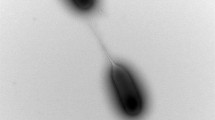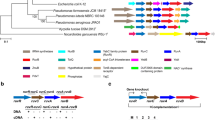Abstract
The main aim of this work was to study molecular characterization of a DNA fragment conferring resistance to Cu(II) in Sinorhizobium meliloti CCNWSX0020. The strain CCNWSX0020, resistant to 1.4 mmol l−1 Cu(II) in tryptone-yeast extract medium was isolated from Medicago lupulina growing in mine tailings of Fengxian County, China. The availability of the complete genome sequence of S. meliloti CCNWSX0020 provides an opportunity for investigating genes that play significant roles in Cu(II) resistance. A copper resistance gene, with a length of 1,445 bp, encoding 481 amino acids, designated omp, was identified by cDNA-amplified fragment length polymorphism from S. meliloti CCNWSX0020. The expression of omp gene strongly increased in the presence of Cu(II). The omp-defective mutants display sensitivities to Cu(II) compared with their wild types. The Cu(II)-sensitive phenotype of the mutant was complemented by a 1.5-kb DNA fragment containing omp gene. BLAST analysis revealed that this gene encoded a hypothetical outer membrane protein with 75 % similarity to outer membrane efflux protein in Rhizobium leguminosarum bv. viciae 3841. These studies suggested that the omp product was involved in the Cu(II) tolerance of S. meliloti CCNWSX0020.




Similar content being viewed by others
References
Beswick PH, Hall GH, Hook AJ, Little K, McBrien DC (1976) Copper toxicity: evidence for the conversion of cupric to cuprous copper in vivo under anaerobic conditions. Chem Biol Interact 14:347–356
Bhattacharyya S, Pal TK, Basumajumdar A (2009) Modulation of enzyme activities of a lead-adapted strain of Rhizopus arrhizus during bioaccumulation of lead. Folia Microbiol 54(6):505–508
Chen CM, Liu MC (2006) Ecological risk assessment on a cadmium contaminated soil landfill a preliminary evaluation based on toxicity tests on local species and site-specific information. Sci Total Environ 359:120–129
Dinh T, Paulsen IT, Saier MH (1994) A family of extracytoplasmic proteins that allow transport of large molecules across the outer membranes of gram-negative bacteria. J Bacteriol 176:3825–3831
Fan LM, Ma ZQ, Lang JQ, Li HF, Wang ET, Wei GH (2011) Characterization of a copper-resistant symbiotic bacterium isolated from Medicago lupulina growing in mine tailings. Bioresour Technol 102:703–709
Grass G, Rensing C (2001) Genes involved in copper homeostasis in Escherichia coli. J Bacteriol 183:2145–2147
Guala SD, Vega FA, Covelo EF (2011) Development of a model to select plants with optimum metal phytoextraction potential. Environ Sci Pollut Res Int 18:997–1003
Habu Y, Fukada-Tanaka S, Hisatomi Y, Iida S (1997) Amplified restriction fragment length polymorphism-based mRNA fingerprinting using a single restriction enzyme that recognizes a 4-bp sequence. Biochem Biophys Res Commun 234:516–521
Hanahan D (1983) Studies on transformation of Escherichia coli with plasmids. J Mol Biol 166:557–580
Matuszewska E, Kwiatkowska J, Kuczynska-Wisnik D, Laskowska E (2008) Escherichia coli heat-shock proteins IbpA/B are involved in resistance to oxidative stress induced by copper. Microbiology 154:1739–1747
Munson GP, Lam DL, Outten FW, O’Halloran TV (2000) Identification of a copper-responsive two component system on the chromosome of Escherichia coli K-12. J Bacteriol 182:5864–5871
Nies DH (1999) Microbial heavy-metal resistance. Appl Microbiol Biotechnol 51:730–750
Oleszczuk P (2007) The evaluation of sewage sludge and compost toxicity to Heterocypris incongruens in relation to inorganic and organic contaminants content. Environ Toxicol 22:587–596
Outten FW, Huffman DL, Hale JA, O’Halloran TV (2001) The independent cue and cus systems confer copper tolerance during aerobic and anaerobic growth in Escherichia coli. J Biol Chem 276:30670–30677
Petersen C, Moller LB (2000) Control of copper homeostasis in Escherichia coli by a P-type ATPase, CopA, and a MerR-like transcriptional activator, CopR. Gene 261:289–298
Pope CR, Flores AG, Kaplan JH, Unger VM (2012) Structure and function of copper uptake transporters. Curr Top Membr 69:97–112
Rajkumar M, Ae N, Freitas H (2009) Endophytic bacteria and their potential to enhance heavy metal phytoextraction. Chemosphere 77:153–160
Rivas R, Vizcaino N, Buey RM, Mateos PF, Martinez-Molina E, Velazquez E (2001) An effective, rapid and simple method for total RNA extraction from bacteria and yeast. J Microbiol Methods 47:59–63
Sambrook J, Russell DW (2001) Molecular cloning: a laboratory manual. Cold Spring Harbor Laboratory Press, Cold Spring Harbor
Sambrook J, Fritsch EF, Maniatis T (1989) Molecular cloning: a laboratory manual. Cold Spring Harbor Laboratory Press, Cold Spring Harbor
Schafer A, Tauch A, Jager W, Kalinowski J, Thierbach G, Puhler A (1994) Small mobilizable multipurpose cloning vectors derived from the Escherichia coli plasmids pK18 and pK19: selection of defined deletions in the chromosome of Corynebacterium glutamicum. Gene 145:69–73
Shore RF, Casulli A, Bologov V, Wienburg CL, Afsar A, Toyne P, Dell’Omo G (2001) Organochlorine pesticide, polychlorinated biphenyl and heavy metal concentrations in wolves (Canis lupus L. 1758) from north-west Russia. Sci Total Environ 280:45–54
Steele KW, Bonish PM, Daniel RM, O’Hara GW (1983) Effect of rhizobial strain and host plant on nitrogen isotopic fractionation in legumes. Plant Physiol 72:1001–1004
Teixeira EC, Franco de Oliveira JC, Marques Novo MT, Bertolini MC (2008) The copper resistance operon copAB from Xanthomonas axonopodis pathovar citri: gene inactivation results in copper sensitivity. Microbiology 154:402–412
Wani PA, Khan MS, Zaidi A (2008) Effect of metal tolerant plant growth-promoting rhizobium on the performance of pea grown in metal amended soil. Arch Environ Contam Toxicol 55:33–42
Yanisch-Perron C, Vieira J, Messing J (1985) Improved M13 phage cloning vectors and host strains: nucleotide sequencing of the M13mp18 and pUC9 vectors. Gene 33:103–119
Acknowledgments
This research was financially supported by the National Natural Science Foundation of China (31125007, 31270012).
Author information
Authors and Affiliations
Corresponding author
Electronic supplementary material
Below is the link to the electronic supplementary material.
Rights and permissions
About this article
Cite this article
Li, Z., Lu, M. & Wei, G. An omp gene enhances cell tolerance of Cu(II) in Sinorhizobium meliloti CCNWSX0020. World J Microbiol Biotechnol 29, 1655–1660 (2013). https://doi.org/10.1007/s11274-013-1328-y
Received:
Accepted:
Published:
Issue Date:
DOI: https://doi.org/10.1007/s11274-013-1328-y




